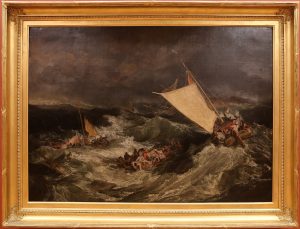Romanticism originated in Europe towards the end of the 18th century and was an artistic, literary, musical, and intellectual movement. In most areas, it reached its peak in the approximate period from 1800 to 1850.

Image source: https://commons.wikimedia.org/wiki/File:Baade-ScenefromtheEraofNorwegianSagas.jpg
In a period between the end of the 18th to the middle of the 19th century in Western civilization, Romanticism was an attitude or intellectual orientation that characterized many works of literature, music, painting, architecture, criticism, and historiography, it can also be seen as a rejection of the precepts of order, harmony, calm, idealization, balance, and rationality that characterized Classicism and in particular the Neoclassicism of the late 18th century.
Where the Romantic movement appeared?

Image source:https://en.wikipedia.org/wiki/German_Romanticism
The Romantic movement originated in Germany, then spread to England, France, and the rest of Europe. America, on the other hand, had its version of Romanticism, the Hudson River School, which was the first truly American art school. The mid-1600s ushered in the Age of Enlightenment (or “Age of Reason”), which was a period that glorified rational thinking, secularism, and scientific progress. However, at the beginning of the 19th century, not everyone believed that science and reason could explain everything and their reaction against the ongoing industrialization became a global movement – Romanticism. They sought inspiration in intuition and imagination by looking beyond reason. The ultimate goal of their artwork was to be emotionally involved.
Return to nature

Image source: https://en.wikipedia.org/wiki/George_Stubbs#/media/File:George_Stubbs_005.jpg
While the Enlightenment philosopher Voltaire (1694 – 1778) preached progress and rationality, his arch-rival Jean-Jacques Rousseau (1712 – 1778), a forerunner of the Romantic movement, advocated a “return to nature.” While many people left rural areas to settle in the city, romantics longed for life in the country. Romantic art despite ongoing urbanization, depicted villages or rural landscapes rather than expanding cities, machines, or factories. This marked a comeback for landscape paintings which were very popular during the Baroque period. In addition to providing a setting for the painting, nature also becomes its main subject, so much so that people are not present or tiny compared to the setting. It is not unusual to see just one or two small figures against an oppressive rural background.
Plein air painting

Image source:https://commons.wikimedia.org/wiki/File:Boys_Fishing_by_David_Cox.jpg
In many countries, Romantic painters have turned their attention to nature and plein air painting, or outdoors painting. Works based on careful observation of the landscape sky and atmosphere have elevated landscape painting to a new and more respectful level. While some artists emphasized human beings as one with and part of nature, others portrayed the power and unpredictability of nature, evoking in the viewer a feeling of sublime – awe mixed with dread.
Romanticism was linked to the emergence of newfound nationalism that swept many countries after the American Revolution. By emphasizing local folklore, traditions, and landscapes, the Romantics provided the visual imagery that further stimulated national identity and pride. Romantic painters combined the ideal with the particular, infusing their paintings with a call to spiritual renewal that would usher in an era of freedom not yet seen.
Romanticism seen as gothic
Romantic art was “gothic.” It was dark, macabre, and grotesque.

Image source:https://commons.wikimedia.org/wiki/File:Jmw_turner,_il_naufragio,_ante_1805,_01.jpg
Romantic artists had long admired the grandeur of Greek and Roman cultures however, they looked with admiration to that pre-Renaissance era: they were convinced that the educated generations that followed could not produce a culture that matched that of the common and uncultivated people of the Middle Ages. Up until that point in Western art history, most works of art focused on beauty, and art was taught as a discipline. Romantic art, on the other hand, was there to fascinate and horrify. Some of their paintings were the most horrifying to see in the West at the time, for example, Saturn Devours His Children by Francisco de Goya.
